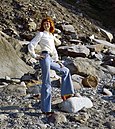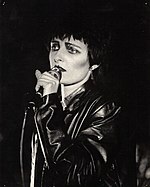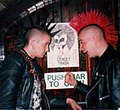1970s in fashion
From Wikipedia, the free encyclopedia

1970s fashion, which began with a continuation of the mini skirts, bell-bottoms and the androgynous hippie look from the late 1960s, was soon sharply characterised by several distinct fashion trends that have left an indelible image of the decade commemorated in popular culture. These include platform shoes which appeared on the fashion scene in 1971 and often had soles 2-4 inches thick. These were worn by both men and women. Wide-legged, flared jeans and trousers were another fashion mainstay for both sexes throughout most of the decade, and this style has been immortalised in the 1977 film Saturday Night Fever which starred John Travolta. The "disco look", complete with three-piece suits for men and wrap-around rayon or jersey dresses for women, which the film launched, lasted until it was gradually replaced by punk fashion and straight, cigarette-legged jeans. Platform shoes gave way to mules and ankle-strapped shoes, both reminiscent of the 1940s, at the very end of the decade.
Contents[hide] |
[edit] Early to Mid 1970s
The decade began with a continuation of the hippie look from the 1960s. Jeans remained frayed, and the Tie dye shirts and Mexican peasant blouses were still popular. In addition to the mini skirt, mid-calf length dresses called "midis" and ankle-length dresses called "maxis" were also worn in 1970 and 1971, thus offering women three different skirt lengths.[1] The latter two were topped in winter by fitted coats of the same length, often lined in sheepskin. A variety of the "maxi" was the high-necked "granny" dress. This was typically worn with lace-up boots and chokers, completing the Victorian effect.
Tunics and Indian fabrics continued to be popular. Long vests (waistcoats) were often worn with mini-skirts.[2] Jeans waistlines lowered to 4 inches or even less as "hip huggers" with "bell-bottoms" became the height of denim fashion. Altering the appearance of jeans with bleach and tie-dye techniques, embroidery, decorative patches, and metal studs was popular as well. Tight-fitting ribbed tops were worn by both sexes. Polyester "doubleknit" fabric was coming into its own, with many clothing items for men and women being produced in this modern easy-care fabric.
In 1971, extremely brief, tight-fitting shorts, called hot pants, were a fashion craze for girls and young women.

In Britain and the urban United States, from 1972-1974, fashions were inspired by extravagantly-dressed glam rock stars such as David Bowie and Roxy Music.[3] Glitter was in vogue. Women wore high-waisted, flared satin trousers or denims, the latter usually decorated with rhinestones, tight lurex halter tops, metallic-coloured lamé and antique velvet dresses, satin hot pants, sequined bra tops, and occasionally they wore ostrich- feather boas draped over their shoulders or turbans on their heads. The 1930s and 1940s look was also popular, and many women bought their clothes at second-hand shops. The short, imitaion rabbit-fur jacket was a hot fashion item during this period. Make-up was garish and glittery, with eyebrows thinly plucked. Bianca Jagger, who often used an ebony walking stick, wore peacock-feathers in her cloche hats, green sequined shoes, transparent blouses, and carried an ivory cigarette- holder, was a fashion icon.[4] The men often wore lamé suits, silver astronaut-style outfits, satin quilted jackets, wide-legged denims or velvet trousers, and rhinestone-studded shirts. Their hair was long and softly layered, or spiky, multi-coloured mullets. Clothing shops which became associated with glam rock-inspired fashion were Biba[5], in London's Kensington High Street, and Granny Takes a Trip in Kings Road, which also had a branch in West Hollywood, California. Both shops had opened in the 1960s.
Platform shoes with soles 2-4 inches thick became the style for both men and women. Men's ties broadened and became more colourful, as did dress shirt collars and suit jacket lapels.
Another tend for both sexes was the fitted blazer, which flared slightly at the hip. It came in a variety of fabrics, including wool, velvet, suede, and leather. The buttons were covered and the lapels wide.
For teenage girls and young women the crop top was often worn, sometimes with a halter neck or else tied in a knot above the midriff.
By the mid-1970s hip-huggers were gone, replaced by the high-waisted jeans and trousers with wide, flared legs. In Britain, they were often referred to as "Loon pants". These lasted until the end of the decade when the straight, cigarette-leg jeans came into vogue.
The dancer's leotard became an important feminine fashion accessory in 1974. It remained in style throughout the decade.
In Britain and Ireland, in the early to mid-1970s, there was the bootboy subculture which influenced youthful male attire with the "parallel jeans", which were flared jeans that stopped at mid-calf. These were worn with heavy workman's "bovver" boots, braces, (US suspenders), and denim jackets. Their hair was usually worn longish by the middle of the decade.
The wrinkled look for women enjoyed a brief vogue in 1975, as did flared denim skirts which ended just below the knee. Trendy colours were dusty rose, Prussian blue, bottle green, rust, and brown.

Fashion influences were peasant clothing, such as blouses with laces or off-the-shoulder necklines, inspired by those worn in the 17th century. Yves St Laurent introduced the peasant look in 1976, and it became very influential. Skirts were gathered into tiers and shoulder lines dropped. Camisoles were worn. Clothing became very unstructured and fluid at this point. Embroidered clothing, either self-made or imported from Mexico or India also enjoyed favour. Floral-patterned prints were in fashion. Fake-flower chokers and hair combs were often worn with the peasant skirts. In 1977, the ruffled sundress coupled with a tight t-shirt worn underneath enjoyed a brief popularity.[6]
[edit] Late 1970s


With the popularization of disco and the increasing availability and diversity of man-made fabrics, a drastic change occurred in mainstream fashion, the likes of which had not been seen since the 1920s. All styles of clothing were affected by the disco style, especially those of men. Men began to wear stylish three-piece suits (which became available in a bewildering variety of colours) which were characterized by wide lapels, wide legged or flared trousers, and high-rise waistcoats (US vests). Neckties became wider and bolder, and shirt collars became long and pointed in a style reminiscent of the "Barrymore" collar that had been popular in the 1920s. The zippered jumpsuit was popular with both men and women, and clothing inspired by modern dance (wrap-around skirts and dresses of rayon or jersey) also became common. Neck-scarves were also used. Skin-tight Spandex trousers, tube tops, and slit skirts were popular for a while at the very end of the decade. In 1978, there was a brief craze for transparent plastic trousers worn with leotards underneath. Silk blouses, spaghetti-strapped tank tops and shirt-waist dresses were also worn. Women's shoes began to echo the 1940s, with high-heeled lower-platform mules--"Candies" made of molded plastic with a single leather strap over the ball of the foot or "BareTraps" made of wood becoming very popular. With the demise of disco late in 1979, these styles (which were by then being criticized as flamboyant) quickly went out of fashion. Designer jeans with straight, cigarette-legs, and painters' pants then started to come into style.
The top fashion models of the 1970s were Lauren Hutton, Margaux Hemingway, Cheryl Tiegs, and Jerry Hall

[edit] Custom T-Shirts / Baseball Jerseys
Short-sleeved t-shirts of various colors personalized with iron-on decal illustrations or appliquéd letters spelling a name or message were very popular among teen and pre-teen boys in the U.S. during the late 70s. It was also the trend for teenagers and young men to carry a pack of cigarettes under the sleeve. Also popular were baseball jerseys or "baseball sleeves" (white shirts with colored sleeves worn under baseball uniform shirts). These were worn plain or with appliquéd pictures or words, as described above.
[edit] One-Piece Swimsuits
American actress Farrah Fawcett, who starred in the 1970s programme Charlie's Angels, was a sex symbol for that time period. Her poster which was released in 1976 and sold 12 million copies, featured the actress with her long mane of streaked-blonde hair, perfect white teeth, and wearing a one-piece swimsuit that launched the trend for the maillot. This was, when it resurged in the 1970s, a sexy, tight swimsuit, with deep neckline and high-cut legs, worn by young women and girls in lieu of the bikini, although it did not entirely replace the latter.
[edit] Three-Piece Suits
The 1970s saw a return to three-piece suits (suits with matching vests), worn with the wide-collar shirts carried over from the 1960s. Sometimes these were worn without ties as dance-club wear, or even in just a vest and jacket combination as depicted in the film Saturday Night Fever. As formal wear, however, the three-piece slowly died out in the early 1980s, by which time the outfit had come to be associated with lawyers.[citation needed]

[edit] Hairstyles
Until the final years of the decade, women and teenage girls wore their hair long, with a centre or side parting, which was a style carried over from the late 1960s. Other hairstyles of the early to mid 1970s included the wavy "gypsy" cut, the layered shag, and the "flicked" style in which the hair was flicked into resembling small wings at the temples. This look was popularised by the stars of the television series Charlie's Angels. Blonde-streaked or "frosted" hair was also popular. In 1978, punk singer Debbie Harry of Blondie sparked a new trend with her shoulder-length, dyed platinum blonde hair worn with a long fringe (bangs). Young men's hair was worn long until well past the mid-1970s. Unlike the unkempt 1960s, it was often worn styled in soft layers. In California, the tousled blond, surfer hair was fashionable for teenage boys and young men. In the early part of the decade sideburns were popular. For blacks in the United States and elsewhere, the afro was worn by both sexes throughout the decade. It was occasionally sported by whites as an alternative to the uniform long, straight hair which was a fashion mainstay until the arrival of punk and the "disco look" when hair became shorter and centre partings were no longer the mode.

[edit] Punk
Punk as a style originated from London from the designer Vivienne Westwood and her partner Malcolm McLaren. Before the Modern world a person who attacked someones cherished beliefs, traditional institutions, etc., as being based on error or superstition. in essence, this movement was a direct reaction to the economic situation during the economic depression of the period. Punk had at its heart a manifesto of creation through disorder. Safety pins became nose and ear jewellery, rubber fetishwear was subverted to become daywear, and images of mass murderers, rapists, and criminals were elevated to iconographic status.
Punk fashion can be traced to the ripped jeans, torn t-shirts, scrappy haircuts, and worn and torn leather jackets sported by members of the Sex Pistols. When they released Anarchy in the UK in 1976,The Sex Pistols were dressed by Malcolm McLaren, their manager, who owned a clothes store called "Let It Rock" in the Kings Road, Chelsea area of London. These styles can be traced back further to New York artists at the Andy Warhol Factory or bands such as the Velvet Underground, Patti Smith Group or New York Dolls. By the 1980s, punk fashion and punk bands had shown up in cities across the world. There was a Do It Yourself quality to the fashion. Some small elements that spoke of a person's punk roots were safety pins, black PVC or tartan bondage trousers, leopard-print t-shirts, mohawk, spikes or harshly dyed hair, filthy tennis-shoes, or pointy Beatle boots. There is an element of a makeshift, thrown together look and a sense of poverty.

[edit] Cosmetics
Cosmetics in the 1970s reflected the contradictory roles ascribed to the modern woman.[7] For the first time since 1900, make-up was chosen situationally, rather than in response to monolithic trends.[7] The era's two primary visions were the daytime "natural look" presented by American designers and Cosmopolitan magazine, and the evening aesthetic of sexualized glamour presented by European designers and fashion photographers.[7] In the periphery, punk and glam were also influential. The struggling cosmetics industry attempted to make a comeback, using new marketing and manufacturing practices.
[edit] Image gallery
Images representing the fashion trends of the 1970s.
|
The early 1970s' fashions were a continuation of the hippie look from the late 1960s. |
Swedish jewelry designer Efva Attling and a friend in Kings Road, London, 1971. She is wearing a "midi" dress. |
German fashion models, 1972. One of the girls is wearing a "maxi" dress. |
|
|
Los Angeles high school students, 1973. The tousled, blond surfer hair was popular for young men in southern California. |
Young woman wearing a 1930s-style dress and platform shoes, 1973. |
Teenage girl in 1974 dressed in glam rock-inspired clothes. She wears a red sequined tube top, gold lamé jacket, and her black velvet skirt comes from a vintage clothing shop. |
|
|
Young woman in a wrap-around rayon dress, 1977. |
Singer David Bowie in 1978. His avant-garde style of dressing exerted a strong influence on fashion in the 1970s. |
Two punks from the late 1970s |
|
|
Debbie Harry of Blondie in 1979. A female punk icon, her dyed platinum blonde hair was widely copied by teenage girls and young women in Britain and America. |
In 1979, there was a 1940s influence in women's fashions. The woman in the photo wears a belted dress, bloused at the chest, and a pair of ankle-strapped shoes |
Black American woman in late 1979 wearing her hair in a short afro. She also wears a silk scarf, which was a popular fashion accessory for women in the 1970s. |
Singer Barry Manilow wears his hair longish in the soft, layered style favoured by men in the 1970s. Photo courtesy of Alan Light. |
|
By the end of the decade, straight-legged jeans were in fashion. They were often worn cuffed, as seen in this photo. |
[edit] External links
- 1970s Fashion History
- 20th Century Fashion History: 1970s
- Men's Fashion History from the 1970s
- It Came from the 1971 Sears Catalog
- Children's clothing from the 1970s
| Wikimedia Commons has media related to: 1970s fashion |
[edit] References
- ^ Paperpast Yearbook, www.paperpast.com/html/1970_fashion.html
- ^ Paperpast Yearbook,www.paperpast.com/html/1970_fashion.html
- ^ The Ziggy Stardust Companion: Glam Rock by Michael Collins, The Independent, 4 May 1997, retrived on 9 March 2009, www.5years.com/glam.htm.
- ^ Christopher Andersen, Jagger Unauthorized, pgs. 247, 255, 284
- ^ www.Vintage-a-Peel.co.uk/dresses/silverbiba.htm
- ^ Paperpast Yearbook,www.paperpast.com/html/1970_fashion.html
- ^ a b c De Castelbajac, p147-48.
|
|||||||||||||||||||||||||||||||























